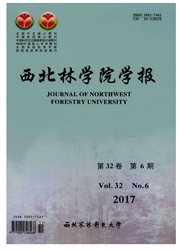

 中文摘要:
中文摘要:
[Objective]The study aimed to discuss the hydrogeochemical features and their temporal and spatial variation in the karst catchment of Lianjiang River,northern Guangdong Province.[Method]Water samples were collected from 10 sub-drainages of Lianjiang River in July of 2012and January of 2013,and then major chemical ions in tributaries of Xingzi River and Tongguanshui River were analyzed in detail to discuss the hydrochemistry type,spatial and temporal distribution and its causes of formation in Lianjiang River basin.[Result]Among chemical ions in the water samples,Ca2+and HCO3-were dominant in Lianjiang River,accounting for over 70%and 80%of total concentrations of cations and anions respectively,followed by Mg2+and SO42-.The concentrations of most major ions were higher in winter than those in summer except SO42-concentration was much higher in summer than that in winter,which was related to anthropogenic factors.From hydrochemical types,it is seen that HCO3--Ca2+type in summer and HCO3--Ca2+?Mg2+type in winter were dominant in Lianjiang River,followed by the HCO3--SO42-?Ca2+type,and only two samples of Xingzi River belonged to HCO3--Ca2+?Mg2+?Na+type in winter.The spatial distribution regularity of chemical ions was not obvious in the 10 sub-drainages of Lianjiang River.The concentrations of chemical ions changed greatly in the upper reaches but slightly in the lower reaches of Xingzi River catchment.The concentrations of chemical ions were steady in Tongguanshui River catchment with a smaller area,and it was a little higher in the upper reaches than those in the lower reaches.[Conclusion]Natural processes,such as lithological heterogeneities and atmospheric precipitation,contributed to the chemical composition of Lianjiang River catchment,northern Guangdong Province.
 英文摘要:
英文摘要:
[ Objective] The study aimed to discuss the hydrogeochemical features and their temporal and spatial variation in the karst catchment of Lianjiang River, northem Guangdong Province. [ Method] Water samples were collected from 10 sub-drainages of Lianjiang River in July of 2012 and January of 2013, and then major chemical ions in tributaries of Xingzi River and Tongguanshui River were analyzed in detail to discuss the hydrochemistry type, spatial and temporal distribution and its causes of formation in Lianjiang River basin. [ Result] Among chemical ions in the wa- ter samples, Ca2. and HCO~- were dominant in Lianjiang River, accounting for over 70% and 80% of total concentrations of cations and anions re- spectively, followed by Mg2+ and SO24-. The concentrations of most major ions were higher in winter than those in summer except SO4^2- concentra- tion was much higher in summer than that in winter, which was related to anthropogenic factors. From hydrochemical types, it is seen that HCO3-- Ca2+ type in summer and HCO3--Ca2+ ~ Mg2. type in winter were dominant in Lianjiang River, followed by the HCO3--SO4^2- · Ca2+ type, and only two samples of Xingzi River belonged to HCO3--Ca2+ Mg2· Na+ type in winter. The spatial distribution regularity of chemical ions was not obvi- ous in the 10 sub-drainages of Lianjiang River. The concentrations of chemical ions changed greatly in the upper reaches but slightly in the lower reaches of Xingzi River catchment. The concentrations of chemical ions were steady in Tongguanshui River catchment with a smaller area, and it was a little higher in the upper reaches than those in the lower reaches. [ Conclusion] Natural processes, such as lithological heterogeneities and at- mospheric precipitation, contributed to the chemical composition of Lianjiang River catchment, northem Guangdong Province.
 同期刊论文项目
同期刊论文项目
 同项目期刊论文
同项目期刊论文
 期刊信息
期刊信息
